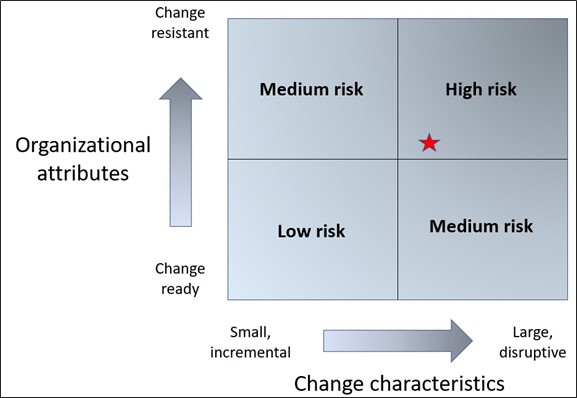Change readiness is about our ability and capacity to lead or deal with change in ways that increase benefits, and minimise risks and negative unintended consequences. It describes the collective state of the organization prior to the implementation of any single or combined change initiative, and its focus is on readiness of people – individually and collectively – as opposed to readiness of technology or process alone. Being ready for a change is vital to its success.
Our readiness to implement a change will depend on many factors. We’ve already looked at some, including our organizational change maturity and the change saturation and fatigue in our department.
In this section we will also look at the history of change in our department, and some of the specifics of our project. We can capture this information in a readiness assessment.
How can we assess our level of readiness?
In assessing our level of readiness we can ask ourselves (including the broader leadership team and important stakeholders) a series of questions, including:
- What is the history of change in the department?
- How were past changes handled?
- How are we incorporating lessons learned from these changes (both positive and negative)?
- Do people understand why this change is necessary?
- Do people accept and believe in the change?
- Have we involved the broader leadership team and stakeholders in developing our case for the change?
- Do people understand the risks of not changing?
- Do people agree on the urgency of the change?
- Are people ready?
- What is the level of senior leadership awareness of the degree of readiness and capacity for change within the organization?
- Do we have data (e.g., from the PSES) that identifies staff perceptions of senior leaders’ willingness and capacity to lead change effectively in the department?
- Are we taking into account change saturation and fatigue?
- Is our organization (including the broader leadership team and key stakeholders) equipped with the knowledge and skills needed to make the change happen? Do we need to take steps to increase our capacity?
- Which people and financial resources will we need? Are funds available to support this?
- Have we taken into account work-life balance and mental health?
- Can our people take on this change in additional to their regular duties? How will we reduce their workload to compensate?
- Give our current set of priorities, where will we be making adjustments and renegotiating priorities to make room for work on the change?
- Which additional resources might be needed to bolster on-going business or changing priorities so that people don’t burn out?
- What is the state of our current technology, structure and systems?
- Will our current technology, structure and systems need to adjust or change?
- How will these affect our change effort and what risks/opportunities do they present?
- Will our current mindset/culture need to be shifted?
- What are the cultural norms needed for our vision to succeed? Will the existing culture work in the new environment?
- What are some key areas that may need to change?
Once we’ve had discussions with a wide range of stakeholders on readiness, we can assess our answers to determine how ready we are for change. We’ll be looking both for red flags and opportunities to grow our change capacity.
Bringing it all together
Now that we have a better appreciation of our organizational level of readiness, we can look at it in relation to the type of change we are dealing with (for more information on the types of change, see Section 1: The type of change we’re leading).
By looking at our readiness and the type of change we can plot the level of risk for our change (for more information on risks, see Section 6: Developing our plans / risk management plan).
The following chart offers a visual of how much overall risk for our organization is represented by the change. It can help us determine how ready our organization is overall, and therefore, how much more we need to invest in building our capacity for change. It can also be helpful for briefing leadership and stakeholders.

Many assessments assign a number to various aspects of change readiness. One way we can do this is to give more weight to particular aspects of readiness than others (e.g., using a scale from 1 to 5). For more information on this, see Section 2: Drivers and barriers / Determine the overall impact of each force.
Ultimately, a scale can help us get some precision on areas to focus on. That being said, it is really both the qualitative data we receive and the discussions themselves that help us to understand our change readiness.
Next steps
Now that we have a better understanding of how ready we are we can examine our leadership’s capacity for change.